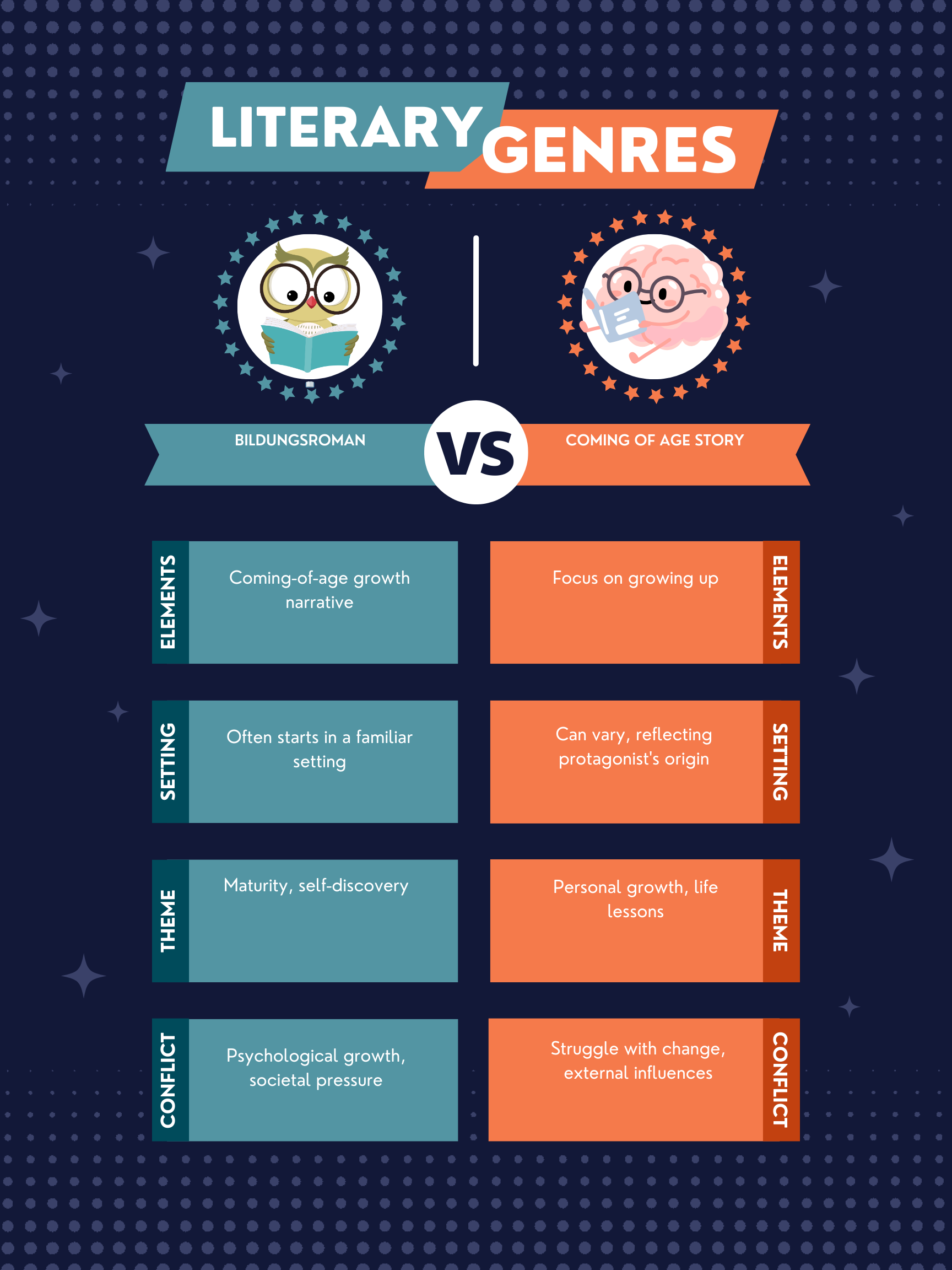Bildungsroman is a literary genre focusing on the psychological and moral growth of the protagonist from youth to adulthood; Coming-of-Age Story emphasizes the narrative of growing up or coming to terms with the world.
Both Bildungsroman and Coming of Age stories delve into the developmental journey of their protagonists, yet they do so through slightly different lenses. Let’s uncover the nuances and similarities of these captivating narrative structures. 🌱📘
Bildungsroman
Bildungsroman, a German term literally meaning “formation novel,” traces the protagonist’s journey from childhood or adolescence into adulthood, focusing on their emotional and moral development. This genre often involves a quest for meaning or self-discovery, with the character undergoing significant personal growth. An iconic example is “The Catcher in the Rye” by J.D. Salinger, which follows Holden Caulfield’s introspective journey through the challenges of adolescent life towards a realization about his place in the world.
Coming of Age Story
A Coming of Age story, while similar to Bildungsroman, has a broader scope and can focus on any key developmental stages of life, not necessarily leading to full maturity. These stories highlight pivotal moments that lead to a newfound understanding or acceptance of the world. Harper Lee’s “To Kill a Mockingbird” serves as a profound example, showcasing Scout Finch’s growth from innocence to a deeper understanding of the complexities and injustices of adult society.
Summary
| Literary Device | Definition | Purpose | Usage | Relevant Examples |
|---|---|---|---|---|
| Bildungsroman | Focuses on the psychological and moral growth of the protagonist from youth to adulthood. | To chart a character’s journey to self-discovery and maturity. | Novels, occasionally in films. | “The Catcher in the Rye” by J.D. Salinger. |
| Coming of Age Story | Emphasizes the narrative of growing up or coming to terms with the world, across various stages of life. | To highlight pivotal moments leading to a greater understanding or acceptance of the world. | Novels, short stories, films, and television. | “To Kill a Mockingbird” by Harper Lee. |
Writing Tips
For writers drawn to the Bildungsroman or Coming of Age genres, consider these insights:
- Focus on Character Development: Ensure that your protagonist undergoes significant change, reflecting on their experiences and evolving as a result.
- Incorporate Universal Themes: Themes like loss, friendship, identity, and the struggle against societal norms can resonate widely.
- Utilize Key Events: Pivotal moments that challenge the protagonist’s beliefs or understanding can catalyze growth.
- Consider the Setting: The world around your protagonist can greatly influence their development. Think about how social, cultural, and historical contexts impact their journey.
FAQs
Can a story be both a Bildungsroman and a Coming of Age story?
Yes, many stories blend elements of both, focusing on character development and key life transitions.
Is Bildungsroman only applicable to novels?
While traditionally associated with novels, the principles of Bildungsroman can apply to other mediums that explore in-depth character growth.
Do Coming of Age stories always involve young protagonists?
Not necessarily. While many Coming of Age stories focus on youth, the term can apply to characters experiencing significant growth at any age.
Exercise
Consider the following summary and identify whether it fits more closely with Bildungsroman or a Coming of Age story:
“A young girl, isolated from society, undergoes a journey of self-discovery after encountering a series of mentors and challenges, ultimately realizing her role in the broader community.”
Answer: This summary aligns more closely with Bildungsroman due to the focus on self-discovery and the protagonist’s psychological and moral growth.
Other Interesting Literary Device Comparisons
- First Person vs. Third Person Narrative: These perspectives alter the intimacy and scope of the storytelling.
- Static vs. Dynamic Characters: Examines the nature of character development, contrasting characters who undergo significant changes with those who remain largely unchanged.
- Plot vs. Theme: Delves into the difference between the events that occur in a story and the underlying messages or meanings.
Exploring these literary devices further can enrich your storytelling and deepen your appreciation for the art of literature. 📚💡

